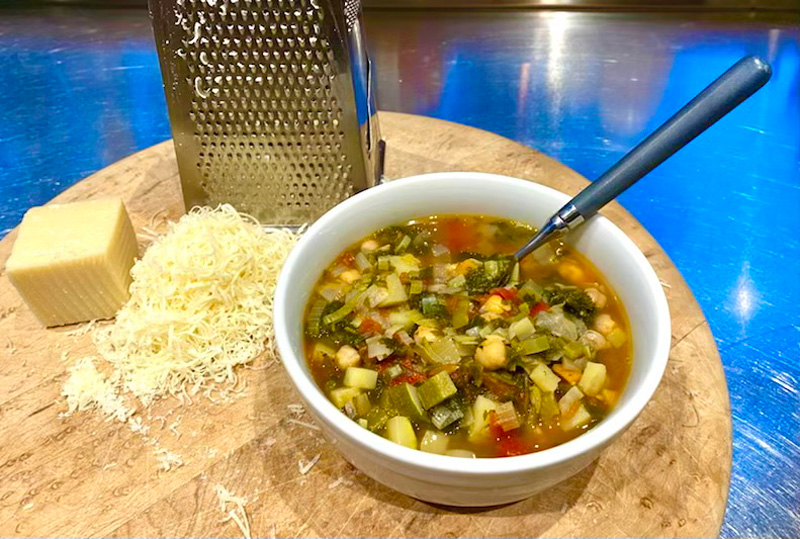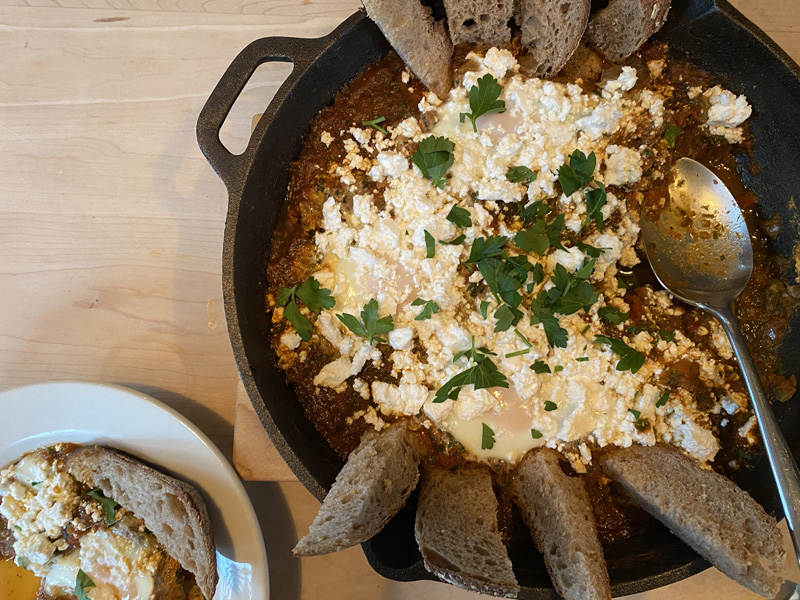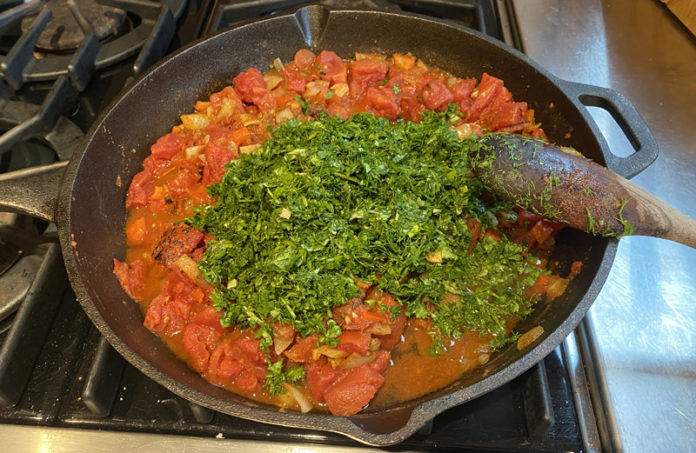My family and I are just home from a life-changing trip to India. We saw the Taj Mahal at dawn, tracked leopards at dusk, and had the great privilege of sitting with His Holiness the Dalai Lama for two days. My entire vocabulary fails to describe this experience, except maybe to say how deeply grateful we feel.
Because of my inability to describe the magical parts of this trip, I find myself telling friends about the more mundane aspects of our Indian travels — the crazy driving and the food. Though, to be fair, we did bump side-view mirrors with two other cars, and dodge cows, camels, dogs, and bikers on the highways, and the food was phenomenal. Highlights include a sublime chana masala with saffron rice in Dharamshala, and gatte ki sabzi with a panchmel dal in Rajasthan. And I have also been reflecting that while rich in flavor, the food in India was a wonderful reminder that keeping it simple is, more often than not, the ultimate recipe for good food. Our best food moments were when the cook let the ingredients work together to shine. Nothing extra. Hot water steeped with cardamom, cinnamon, fennel, and a bit of sugar at a small pashmina shop in Delhi. Wow.
On our first night home, we ate baked potatoes from Morning Glory Farm with some sharp Cheddar cheese and roasted asparagus, and went to bed at 5:30 pm. After so much flavor, it was nice to eat something super-plain yet nourishing. We all woke up at 2:30 am and had some tea and toast, did five loads of laundry, exercised before the sun was up, and then made simple cheese omlettes as our second breakfast. The second night we were home, we were extremely tired at 3 pm. I made beans with green chilis, garlicky guacamole, and steamed rice, and we went to bed at 6 pm. The carbohydrates helped us sleep all the way until 3:45 am. As we started adjusting to the time, I continued to keep our meals simple. It was rainy the next night, so I pulled together a minestrone soup featuring onions, leeks, potatoes, carrots, celery, and kale from Ghost Island Farm, which took about a half-hour to make and 15 minutes to eat, and we were back in bed at 6:45 pm. We didn’t eat a ton of eggs while we were away, so I opted for a shakshuka the next night. Again, I stopped by Island farms for key ingredients — fresh tomatoes, a red pepper, an onion, cilantro. And I found some sensational seeded spelt bread to pair with the eggs at the Chilmark General Store. Yum.
Friends who live off-Island and take regular advantage of food delivery services often say to me, “Isn’t it so much work to cook every night?”
I say, “It isn’t. Unless you make it more work than it needs to be, and have the time for something elaborate.”
And then comes the inevitable question from anyone who isn’t vegetarian: “Do you really feel satisfied with vegetarian dinners? Do they give you enough energy?”
“For me? Absolutely,” I say.
“But vegetarian meals take so much more thought and work,” they say.
I am here to say they don’t. Even when I am cooking on jet-lagged fumes, pulling a vegetarian dinner together that is nutritious and satisfying is easy. It all comes down to keeping it simple, fresh, and local. Yes, there are nights where I’ll make something like Taiwanese Meefun, which is an investment in time (why I always double for leftovers!), and involves a zillion steps and a tremendous amount of chopping. Most nights I aim for easy and flavorful. I am not above using canned beans or a jar of tomatoes to make the cooking process more efficient. And I will often use just a few ingredients to make things easier. In fact, one of our favorite family meals is Eric Kim’s Sheet-Pan Bibimbap, which uses leftover rice and pairs it with roasted sweet potatoes, kale, mushrooms, onions, and eggs. These ingredients, combined with some gochujang, make for a sensational supper. And yet so simple!
As for my family getting enough nutrients and protein from these meals, I am of the mind that one does not need animal protein, starch, and a vegetable on a plate every night. I am not alone in this thinking. The Mayo Clinic says, “A plant-based diet, which emphasizes fruits, vegetables, grains, beans, legumes, and nuts, is rich in fiber, vitamins, and other nutrients. And people who don’t eat meat — vegetarians — generally eat fewer calories and less fat, weigh less, and have a lower risk of heart disease than nonvegetarians do. Even reducing meat intake has a protective effect.” This is because research shows that people who eat red meat are at an increased risk of death from heart disease, stroke, or diabetes. And having a predominantly plant-based diet is not a new concept. Pythagoras was extolling the benefits of a plant-based diet in ancient Greece.
This all said, I am not trying to convert you or anyone to become a vegetarian. But I do believe that folks can and should weave plant-based meals into their weekly meal regimens — for their health and the health of the planet. Less meat also means less climate change–inducing and potent greenhouse gas methane. In fact, Scientific American reports that if every American reduced their red meat intake by just 25 percent, it would reduce global emissions by 1 percent. Pretty cool, right?
So I am offering three plant-based meals to try. I am not going to call them recipes, as they really are just basic outlines for a great vegetable soup; black beans that kids and adults alike adore, and can be used in a burrito, a quesadilla, in taco shells, or just paired with rice (or even with some leftover meat!); and an egg recipe that even my daughter’s pickiest friend found delicious.
Make them often. Make them with ease. Make them yours.

Minestrone for a Rainy Night
Serves 4 or 6, with enough for lunch the following day. Note: No need to pre-chop anything, as this is worked into the timing.
3-4 Tbsp. olive oil 1 large sweet onion, diced 5 leeks, thinly sliced and chopped 5 stalks celery, small dice 3-4 carrots, small dice 2 bay leaves 2 bunches of Italian parsley, chopped 1 large Parmesan rind 3-4 largish Yukon potatoes, small dice 1 can diced tomatoes (I like Muir Glen) 1 can chickpeas (I like Westbrae) 1 tsp. Better than Bouillon Vegetable Base in two cups boiling water 1-2 bunches lacinato kale, chopped into ribbons 1-2 zucchini, depending upon size, cut into small cubes Parmesan loaf of crusty French bread
As the olive oil heats in a heavy pan, chop onions and throw them in the pan. While the onions soften, chop the leeks, and then throw them in. Cook onions and leeks for 10 minutes. While that is cooking, chop celery and carrots. Add them. Stir. Add the bay leaves.
Chop parsley and potatoes. When the celery and leeks become fragrant, add the parsley, potatoes, and Parmesan rind. Stir around. Cook for a minute or two.
Add the tomatoes. Cook for a minute or two. Add the chickpeas. Add the 2 cups of vegetable broth, along with 2-3 more cups of boiling water. Stir around. Chop kale and zucchini. Add this to the mixture. Cook until the potatoes are done. Serve with Parmesan.
Alternate: Ladle soup into ovenproof bowls, place slices of French bread on the soup, and put a handful of Parmesan on top. Place on a cookie sheet and broil for a minute or two until the cheese melts and turns golden.
Additional thought: My friend Gail Arnold and I were chatting, and she too follows this basic outline for minestrone, but she uses a mushroom dashi powder for her broth, which adds another layer of umami to the recipe.

Everyday Easy Black Beans
Serves 4
a few glugs good olive oil a large sweet onion, finely chopped a zucchini — if it is in season, or you are craving some green crunch — chopped into ¼-inch dice corn from a cob, if you have one laying around, or about 1 cup frozen corn (or no corn, if you don’t like corn) heaping Tbsp. chili powder two heaping tsp. cumin a tsp. or so of maple syrup can of green chilis, or about ¼ cup of some green Hatch chilis a shake of Bragg Aminos — maybe a tsp.? two 15-oz. cans organic black beans (I like Westbrae), or three cups cooked black beans, rinsed large heaping handful of cilantro (unless it tastes like soap to you), chopped
Sauté the onions in a few glugs of olive oil for a few minutes. Add the zucchini and corn. Cook for about three minutes. Add the cumin, chili powder, and green chilis, Bragg Aminos, and maple syrup. Cook for a minute or two. Add the beans. Cook until the beans are warm. Add cilantro. You are done.
What to do now? Serve with steamed rice, some grated sharp Cheddar cheese, and guacamole.
OR:
Make burritos!
Heat oven to 350°. Make rice. While rice is cooking, sauté some kale (or spinach, or chard!) in a bit of olive oil, butter, garlic, and chili flakes. Grate some sharp Cheddar cheese.
Take a large flour or corn tortilla, place it on some aluminum foil (large enough to wrap the tortilla up into a burrito), place the cheese on the tortilla, add some rice, beans, and greens on top. Roll the tortilla up in the foil, and place in the oven for about 12 minutes. Serve with guacamole and sour cream.
OR:
Make tacos!
Chop up some crunchy romaine, red onions, red peppers, cucumbers, and whatever else you and your family like on tacos. Grate some sharp Cheddar or Monterey Jack cheese. Place all fixin’s in pretty bowls at the center of the table. Maybe include some salsa, guacamole, and sour cream? Hot sauce too!
Heat up taco shells. Put the beans in the taco shells, and let folks jazz them up.
OR:
Make quesadillas!
Place a large tortilla in a wrought-iron pan. Put some grated Cheddar or Monterey Jack cheese on the tortilla. Add the beans. Put another tortilla on top. Cook until the cheese begins to melt. Flip, and serve. Best served post-surf or -sledding!

Shakshuka for a Sunday Night
Serves 3-4 people. This recipe is based on two shakshuka recipes: Melissa Clark’s excellent one for the New York Times and Yotam Ottolenghi’s wonderful shakshuka, which I tried for the first time at his London restaurant on Pavilion Road. I loved Ottolenghi’s so much I dragged my family back across town to have it two mornings in a row. This said, I have tweaked the recipe a bit because big chunks of cooked red pepper do not appeal to me, but at the same time I do appreciate the fact that the red pepper adds umami and sweetness to the mixture, so I purée my tomato mixture to solve my red pepper issue. Try this, try hers, or try his. They are all easy and soooo good!
a few big glugs of good extra-virgin olive oil 1 large sweet onion, roughly chopped 1 large red bell pepper, seeded and roughly chopped 2 garlic cloves, crushed 2 tsp. ground cumin 2-3 tsp. sweet paprika ⅛ tsp. ground cayenne, or to taste Large bunch cilantro, chopped 1 28-oz. can diced plum tomatoes (again, I like Muir Glen) ½ tsp. kosher salt ¼ tsp. black pepper 6 large eggs 6 oz. feta, crumbled (about 1-1½ cups) or grated sharp Cheddar (If you don’t have feta fans)
Heat oven to 375°.
Heat oil in a large skillet over medium heat. Add onion and bell pepper. Cook gently until very soft. Add garlic and cook for another minute. Add cumin, paprika, and cayenne, and cook for a minute or so. Add a few handfuls of the cilantro. Pour in tomatoes, and season with salt and pepper to taste. Cook for about 10 minutes, until the tomato mixture feels like it has coalesced. Using an immersion blender, gently purée the mixture so that it feels like two-thirds of it has been chopped up.
Make six divots in the tomato mixture, and crack an egg into each divot. Transfer skillet to oven, and bake until eggs are just set, about seven minutes. Sprinkle the cheese over the eggs, and cook for a few more minutes. When the eggs are done, pull them out, toss the remaining cilantro over the eggs and sauce, and serve with crusty bread.
















